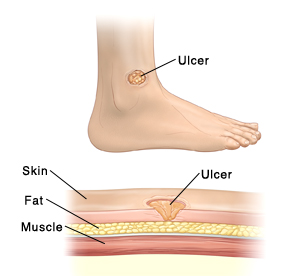A pressure injury is a sore on the skin. Pressure injuries often form when blood circulation is impaired. Using a wheelchair or not leaving your bed due to illness or disability can cause pressure that may lead to pressure injuries. Pressure injuries are generally round areas of red, swollen, thickened skin around a crater-like depression. They are often very slow to heal. If a pressure injury isn't correctly treated, it may become infected. If the infection spreads, it can cause serious health issues.
Symptoms of a pressure injury include:
-
Reddish area on the skin
-
Skin color and texture changes
-
Swelling
-
Wound that isn't healing
-
Crater in the skin
-
Pain
-
Drainage or pus
Risk factors
There are many risk factors for pressure injuries. Some of these include:
-
Decreased blood flow to a part of the skin (vascular insufficiency)
-
Trauma
-
Lack of or little movement of a part of the body for long periods of time
-
Infection
-
Poor hygiene
-
Varicose veins
-
Vitamin deficiency
-
Diabetes
Pressure injuries
Pressure injuries are a type of skin injury. They're most often seen in people who use a wheelchair or who can't leave their bed. They're caused by prolonged pressure to a spot on the skin. Pressure injuries often occur on the back, buttocks, or backs or sides of the legs, arms, or feet (especially the heels).
Home care
You may be prescribed antibiotics to prevent infection. If this is the case, be sure to take all of the medicine, even if your symptoms get better. You may also be given medicines to help relieve pain. Follow the healthcare provider’s instructions when using these medicines. You'll also be taught how to keep pressure off the affected area. And how to use different positions and supports to prevent pressure injuries to other parts of the body. Assistive mobility devices, such as wheelchairs and canes, or skin protectors may also be checked. This is to make sure they're a correct fit for your body.
General care
-
Care for the skin ulcer as instructed. Always wash your hands with soap and clean, running water before and after caring for your wound.
-
Cover the ulcer with a clean, dry bandage. Remove and change the bandage as advised. If the bandage becomes wet or dirty, change it as soon as possible.
-
Follow the healthcare provider’s instructions about washing. You can shower, but don't soak the healing ulcer until the provider says it’s OK.
-
Don't scratch, rub, or pick at the healing skin.
-
Check the area every day for signs of infection, such as increasing pain, redness, warmth, red streaking, swelling, or pus draining from the pressure injury.
-
When resting, raise the area where the pressure injury is above the level of the heart.
-
Don't smoke or drink alcohol. These can delay wound healing.
-
If you're able to, try to walk regularly. This can help with circulation.
-
Don't stand or sit in one1position for long periods.
-
Ask about home physical therapy services if you're weak and need to gain strength so you can move.
The following tips can help prevent future pressure injuries:
-
Know your risks for pressure injuries.
-
Keep the skin clean and dry.
-
Reposition frequently.
-
Use protective devices, such as pillows, foam wedges, and heel protectors for the knees, ankles, and heels.
-
Don't stay in one spot.
-
Exercise as tolerated.
-
If mobility or protective devices are used, check them on a regular schedule to make sure they fit correctly.
Follow-up care
Follow up with your healthcare provider, or as advised.
When to get medical care
Call your healthcare provider right away if any of these occur:
-
Fever of 100.4°F (38°C) or higher, or as advised by your provider
-
Signs of infection. These include increasing pain, warmth, redness, or pus draining from the pressure injury.
-
Bleeding from the pressure injury
-
Pain in or around the pressure injury that doesn't get better even with medicines
-
Increased swelling
-
Changes in skin color
-
A new pressure injury


